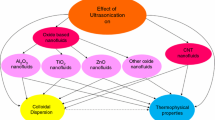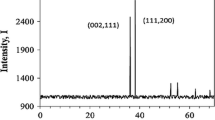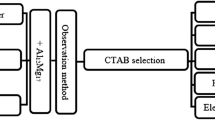Abstract
The objective of this research is to examine how ultrasonication time affects agglomeration, stability, thermal conductivity, and viscosity of CuO nanofluid. Using different reaction conditions, distinct shaped CuO nanoparticles are synthesised and dispersed in an EG: DW (70:30) ratio with 0.3 vol%. Microscopic and TEM images are used to analyze colloidal solutions with varying sizes and shapes of nanoparticles. After 30 days of preparation, the zeta potential is measured to ensure that the suspension is stable. The Bridgman equation is used to compute thermal conductivity using sound velocity values. Viscosity of colloidal suspension is measured by viscometer. All of the studies are performed at 30° ± 2 °C room temperature for ultrasonication times ranging from 30–120 min. At an optimal sonication time of 80 min, there is less agglomeration and more stable particle dispersion. In comparison to other morphological suspensions, CuO spherical shape suspended nanofluid has the lowest viscosity and maximum thermal conductivity, as well as the most stable fluid. At the optimal sonication period, measured results demonstrate thermal increase and decreased viscosity, which could have implications for heat transfer applications.




Similar content being viewed by others
References
Saidur R, Leong KY, Mohammed HA. A review on applications and challenges of nanofluids. Renew Sustain Energy Rev Elsevier. 2011;15:1646–68.
Garg P, Alvarado JL, Marsh C, Carlson TA, Kessler DA, Annamalai K. An experimental study on the effect of ultrasonication on viscosity and heat transfer performance of multi-wall carbon nanotube-based aqueous nanofluids. Int J Heat Mass Transf. 2009;52:5090–101.
El-Genk MS, Tournier J-M. Noble gas binary mixtures for gas-cooled reactor power plants. Nucl Eng Des. 2008;238:1353–72.
Das SK, Choi SU, Yu W, Pradeep T. Nanofluids: science and technology. Hoboken: John Wiley & Sons; 2007.
Berrada N, Hamze S, Desforges A, Ghanbaja J, Gleize J, Mare T, et al. Surface tension of functionalized MWCNT-based nanofluids in water and commercial propylene-glycol mixture. J Mol Liq. 2019;293:111473.
Gomez-Villarejo R, Aguilar T, Hamze S, Estellé P, Navas J. Experimental analysis of water-based nanofluids using boron nitride nanotubes with improved thermal properties. J Mol Liq. 2019;277:93–103.
Das SK, Choi SU, Patel HE. Heat transfer in nanofluids—a review. Heat Transf Eng Taylor & Francis. 2006;27:3–19.
Choi SU, Eastman JA. Enhancing thermal conductivity of fluids with nanoparticles. Argonne National Lab., IL (United States). 1995.
Sivashanmugam P. Application of nanofluids in heat transfer. An overview of heat transfer phenomena, InTechOpen; 2012.
Eastman JA, Choi US, Li S, Thompson LJ, Lee S. Enhanced thermal conductivity through the development of nanofluids. Argonne National Lab., IL (United States); 1996.
Minea AA, Estellé P. Numerical study on CNT nanofluids behavior in laminar pipe flow. J Mol Liq. 2018;271:281–9.
Eastman JA, Choi SUS, Li S, Yu W, Thompson LJ. Anomalously increased effective thermal conductivities of ethylene glycol-based nanofluids containing copper nanoparticles. Appl Phys lett. 2001;78:718–20.
Chen H, Witharana S, Jin Y, Kim C, Ding Y. Predicting thermal conductivity of liquid suspensions of nanoparticles (nanofluids) based on rheology. Particuology. 2009;7:151–7.
Lee S, Choi S-S, Li SA, Eastman JA. Measuring thermal conductivity of fluids containing oxide nanoparticles. J Heat Transf. 1999. https://doi.org/10.1115/1.2825978.
Buongiorno J, Venerus DC, Prabhat N, McKrell T, Townsend J, Christianson R, et al. A benchmark study on the thermal conductivity of nanofluids. J Appl Phys. 2009;106:094312.
Wong KV, Castillo MJ. Heat transfer mechanisms and clustering in nanofluids. Adv Mech Eng. 2010;2:795478.
Kole M, Dey TK. Thermal conductivity and viscosity of Al2O3 nanofluid based on car engine coolant. J Phys D Appl Phys. 2010;43:315501.
Xuan Y, Li Q. Heat transfer enhancement of nanofluids. Int J Heat Fluid Flow. 2000;21:58–64.
Zeroual S, Estellé P, Cabaleiro D, Vigolo B, Emo M, Halim W, et al. Ethylene glycol based silver nanoparticles synthesized by polyol process: characterization and thermophysical profile. J Mol Liq. 2020;310:113229.
Asadi A, Alarifi IM, Ali V, Nguyen HM. An experimental investigation on the effects of ultrasonication time on stability and thermal conductivity of MWCNT-water nanofluid: finding the optimum ultrasonication time. Ultrason Sonochemistry. 2019;58:104639.
Riahi A, Khamlich S, Balghouthi M, Khamliche T, Doyle TB, Dimassi W, et al. Study of thermal conductivity of synthesized Al2O3-water nanofluid by pulsed laser ablation in liquid. J Mol Liq. 2020;304:112694.
Munyalo JM, Zhang X. Particle size effect on thermophysical properties of nanofluid and nanofluid based phase change materials: a review. J Mol Liq. 2018;265:77–87.
Banisharif A, Aghajani M, Van Vaerenbergh S, Estellé P, Rashidi A. Thermophysical properties of water ethylene glycol (WEG) mixture-based Fe3O4 nanofluids at low concentration and temperature. J Mol Liq. 2020;302:112606.
Hong T-K, Yang H-S, Choi CJ. Study of the enhanced thermal conductivity of Fe nanofluids. J Appl Phys. 2005;97:064311.
Garg J, Poudel B, Chiesa M, Gordon JB, Ma JJ, Wang JB, et al. Enhanced thermal conductivity and viscosity of copper nanoparticles in ethylene glycol nanofluid. J Appl Phys. 2008;103:074301.
Leena M, Srinivasan S. Synthesis and ultrasonic investigations of titanium oxide nanofluids. J Mol Liq. 2015;206:103–9.
Shah J, Ranjan M, Gupta SK, Sonvane Y. Ultrasonication effect on thermophysical properties of Al2O3 nanofluids. In: AIP conference proceedings. AIP Publishing LLC; 2018. p. 020008.
Amrollahi A, Hamidi AA, Rashidi AM. The effects of temperature, volume fraction and vibration time on the thermo-physical properties of a carbon nanotube suspension (carbon nanofluid). Nanotechnology. 2008;19:315701.
Yang Y, Grulke EA, Zhang ZG, Wu G. Thermal and rheological properties of carbon nanotube-in-oil dispersions. J Appl Phys. 2006;99:114307.
Kwak K, Kim C. Viscosity and thermal conductivity of copper oxide nanofluid dispersed in ethylene glycol. Korea-Australia Rheology Journal. Korean Society of Rheology/한국유변학회. 2005;17:35–40.
Chung SJ, Leonard JP, Nettleship I, Lee JK, Soong Y, Martello DV, et al. Characterization of ZnO nanoparticle suspension in water: effectiveness of ultrasonic dispersion. Powder Technol. 2009;194:75–80.
Thomas S, Sobhan CBP. A review of experimental investigations on thermal phenomena in nanofluids. Nanoscale Res Lett. 2011;6:377.
Mason JM, Hagemann UB, Arndt KM. Role of hydrophobic and electrostatic interactions in coiled coil stability and specificity. Biochem ACS Publ. 2009;48:10380–8.
Meyer JP, Adio SA, Sharifpur M, Nwosu PN. The viscosity of nanofluids: a review of the theoretical, empirical, and numerical models. Heat Transf Eng Taylor & Francis. 2016;37:387–421.
Suganthi KS, Anusha N, Rajan KS. Low viscous ZnO–propylene glycol nanofluid: a potential coolant candidate. J Nanoparticle Res. 2013;15:1986.
Ying C, Zhaoying Z, Ganghua Z. Effects of different tissue loads on high power ultrasonic surgery scalpel. Ultrasound Med & Biology. 2006;32:415–20.
Xia E-Q, Ai X-X, Zang S-Y, Guan T-T, Xu X-R, Li H-B. Ultrasound-assisted extraction of phillyrin from Forsythia suspensa. Ultrason Sonochem. 2011;18:549–52.
Hartmann NB, Jensen KA, Baun A, Rasmussen K, Rauscher H, Tantra R, et al. Techniques and protocols for dispersing nanoparticle powders in aqueous media—is there a rationale for harmonization? J Toxicol Environ Health Part B Taylor & Francis. 2015;18:299–326.
Park J, An K, Hwang Y, Park J-G, Noh H-J, Kim J-Y, et al. Ultra-large-scale syntheses of monodisperse nanocrystals. Nature Mater Nat Publ Group. 2004;3:891–5.
Noroozi M, Azmi BZ, Moksin MM. The reliability of optical fiber-TWRC technique in liquids thermal diffusivity measurement. Infrared Phys & Technol. 2010;53:193–6.
Pradhan S, Hedberg J, Blomberg E, Wold S, Wallinder IO. Effect of sonication on particle dispersion, administered dose and metal release of non-functionalized, non-inert metal nanoparticles. J Nanoparticle Res. 2016;18:285.
Verwey EJW, Overbeek JTG, Van Nes K. Theory of the stability of lyophobic colloids: the interaction of sol particles having an electric double layer. Amsterdam: Elsevier Publishing Company; 1948.
Ilyas SU, Pendyala R, Marneni N. Stability of Nanofluids. In: Korada VS, Hisham B Hamid N, editors. Engineering applications of nanotechnology [Internet]. Cham: Springer International Publishing; 2017 [cited 2022 Jan 13]. p. 1–31. Available from: http://link.springer.com/https://doi.org/10.1007/978-3-319-29761-3_1
Ruan B, Jacobi AM. Ultrasonication effects on thermal and rheological properties of carbon nanotube suspensions. Nanoscale Res Lett. 2012;7:1–14.
Kiruba R, Gopalakrishnan M, Mahalingam T, Jeevaraj A. Ultrasonic studies on zinc oxide nanofluids. J Nanofluids Am Sci Publ. 2012;1:97–100.
Yadav RR, Mishra G, Yadawa PK, Kor SK, Gupta AK, Raj B, et al. Ultrasonic properties of nanoparticles-liquid suspensions. Ultrasonics. 2008;48:591–3.
Álvarez-Arenas TG, Segura LE, de Sarabia ERF. Characterization of suspensions of particles in water by an ultrasonic resonant cell. Ultrasonics. 2002;39:715–27.
Shah J, Ranjan M, Gupta SK, Satyaprasad A, Chaki S, Sonvane Y. Reaction temperature dependent shape-controlled studies of copper-oxide nanocrystals. Mater Res Express. 2018;5:065037.
Shah J, Kumar S, Ranjan M, Sonvane Y, Thareja P, Gupta SK. The effect of filler geometry on thermo-optical and rheological properties of CuO nanofluid. J Mol Liq. 2018;272:668–75.
Senthilraja S, Vijayakumar K, Gangadevi R. A comparative study on thermal conductivity of Al2O3/water, CuO/water and Al2O3–CuO/water nanofluids. Dig J Nanomater Biostruct. 2015;10:1449–58.
Zhao H, Zhou XX, Pan LY, Wang M, Chen HR, Shi JL. Facile synthesis of spinel Cu 1.5 Mn 1.5 O 4 microspheres with high activity for the catalytic combustion of diesel soot. RSC Adv. 2017;7:20451–9.
Sun CC. Thermal expansion of organic crystals and precision of calculated crystal density: a survey of cambridge crystal database. J Pharm Sci. 2007;96:1043–52.
Kedzierski MA. Viscosity and density of CuO nanolubricant. Int J Refrig. 2012;35:1997–2002.
Wu Z, Yang S, Wu W. Shape control of inorganic nanoparticles from solution. Nanoscale R Soc Chem. 2016;8:1237–59.
Chen G, Xu C, Huang X, Ye J, Gu L, Li G, et al. Interfacial electronic effects control the reaction selectivity of platinum catalysts. Nat Mater Nat Publ Group. 2016;15:564–9.
Ullah MH, Kim I, Ha C-S. One-step synthetic route for producing nanoslabs: Zn-oriented polycrystalline and single-crystalline zinc oxide. J Mater Sci. 2006;41:3263–9.
Hanus LH, Sooklal K, Murphy CJ, Ploehn HJ. Aggregation kinetics of dendrimer-stabilized CdS nanoclusters. Langmuir ACS Publ. 2000;16:2621–6.
Nguyen CT, Desgranges F, Galanis N, Roy G, Maré T, Boucher S, et al. Viscosity data for Al2O3–water nanofluid—hysteresis: is heat transfer enhancement using nanofluids reliable? Int J Therm Sci. 2008;47:103–11.
Feigl CA, Barnard AS, Russo SP. Modelling polar wurtzite ZnS nanoparticles: the effect of sulphur supersaturation on size-and shape-dependent phase transformations. J Mater Chem. 2012;22:18992–8.
Shah J, Ranjan M, Davaria V, Gupta S, Sonvane Y. Temperature-dependent thermal conductivity and viscosity of synthesized α-Alumina nanofluids. Appl Nanosci. 2017;7:803–13.
Rashin MN, Hemalatha J. A novel ultrasonic approach to determine thermal conductivity in CuO–ethylene glycol nanofluids. J Mol Liq. 2014;197:257–62.
Vandsburger L, Swanson EJ, Tavares J, Meunier J-L, Coulombe S. Stabilized aqueous dispersion of multi-walled carbon nanotubes obtained by RF glow-discharge treatment. J Nanoparticle Res. 2009;11:1817.
Mahbubul IM, Chong TH, Khaleduzzaman SS, Shahrul IM, Saidur R, Long BD, et al. Effect of ultrasonication duration on colloidal structure and viscosity of alumina–water nanofluid. Ind & Eng Chem Res. 2014;53:6677–84.
Sadeghi R, Etemad SG, Keshavarzi E, Haghshenasfard M. Investigation of alumina nanofluid stability by UV–vis spectrum. Microfluid Nanofluid. 2015;18:1023–30.
Nishant K, Sonawane SS. Influence of CuO and TiO2 nanoparticles in enhancing the overall heat transfer coefficient and thermal conductivity of water and ethylene glycol based nanofluids. Res J Chem Environ. 2016;20:8.
Zeroual S, Loulijat H, Achehal E, Estellé P, Hasnaoui A, Ouaskit S. Viscosity of Ar-Cu nanofluids by molecular dynamics simulations: effects of nanoparticle content, temperature and potential interaction. J Mol Liq. 2018;268:490–6.
Alias H, Ani MFC, Sa’ad SF, Ngadi N. Heat transfer of alumina-deionized water nanofluids in concentric tube heat exchanger. In: AIP Conference Proceedings. AIP Publishing LLC; 2017. p. 020001.
Shahsavar A, Salimpour MR, Saghafian M, Shafii MB. An experimental study on the effect of ultrasonication on thermal conductivity of ferrofluid loaded with carbon nanotubes. Thermochim Acta. 2015;617:102–10.
Starr FW, Douglas JF, Glotzer SC. Origin of particle clustering in a simulated polymer nanocomposite and its impact on rheology. J Chem Phys. 2003;119:1777–88.
Acknowledgments
Special thanks to Dr. Yogesh Sonvane, Assistant Professor, Department of Applied Physics, SVNIT, Surat, India, Dr, Sanjeev K. Gupta, Assistant Professor, St. Xavier's College, Ahmedabad, India, and Dr. Saket Kumar, IIT Gandhinagar, Gujarat, India for useful discussion and the provision of equipment required for testing.
Author information
Authors and Affiliations
Contributions
JS contributed to Investigation, Conceptualization, Visualization, Data curation, Formal analysis, Writing—original draft, Writing—review & editing. MR contributed to Supervision, Formal analysis, Methodology, Writing—reviewing & editing. PT contributed to Supervision, Data curation, Formal analysis. PE contributed to Supervision, Formal analysis, Writing—review & editing.
Corresponding authors
Additional information
Publisher's Note
Springer Nature remains neutral with regard to jurisdictional claims in published maps and institutional affiliations.
Rights and permissions
About this article
Cite this article
Shah, J., Ranjan, M., Thareja, P. et al. Tailoring stability and thermophysical properties of CuO nanofluid through ultrasonication. J Therm Anal Calorim 147, 10319–10328 (2022). https://doi.org/10.1007/s10973-022-11266-y
Received:
Accepted:
Published:
Issue Date:
DOI: https://doi.org/10.1007/s10973-022-11266-y




